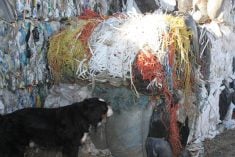American wheat farmers say they’re happy with the financial aid they’ve received from their federal government.
And they say they wouldn’t complain if their counterparts north of the border got a similar helping hand from Ottawa.
“They have the same problems we do,” said Jim Stonebrink, president of the United States National Association of Wheat Growers. “We don’t have a problem with the Canadian farmer getting the same assistance as we do, as long as it’s not based on exports.”
While grain farmers from Sask-atchewan and Manitoba have been rebuffed in their calls for a $1.3 billion aid package to compensate them for low world grain prices, American wheat growers have been cashing government cheques that can provide a Great Plains wheat farmer well over $2 a bushel (U.S.) in direct support payments.
Read Also

Message to provincial agriculture ministers: focus on international trade
International trade stakeholders said securing markets in the face of increasing protectionism should be the key priority for Canada’s agriculture ministers.
Existing subsidy programs in the U.S. were recently bolstered by $8.7 billion in emergency assistance, which will put an estimated $18,000 into the pocket of a typical North Dakota wheat farmer.
Stonebrink said even with the support payments, which he called “survival assistance,” U.S. farmers aren’t making money.
Given credit
But he commended Washington for responding appropriately to the farm income crisis.
“They have basically given us what we’ve asked for, but we’re not asking for anything more than getting enough money to put another crop in the ground,” he said in an interview from his farm at Enterprise, Oregon.
Larry Sawatzky, who follows U.S. farm policy for the Canadian Wheat Board, said it’s not surprising that American wheat growers are satisfied, given the huge payments they get from Washington.
Here’s what a typical North Dakota wheat farmer can receive in government payments:
- Under the 1996 Farm Bill, farmers who participated in farm programs in one of the previous five years were eligible to sign seven-year “production flexibility contracts.” In 1999, those contracts provided wheat growers with cash payments of 63 cents a bushel on 85 percent of their historical acreage (or roughly 55 cents on their total acreage.)
- The government provides farmers with interim financing on their crop production. Each year the U.S. Department of Agriculture sets a loan rate price for various commodities. For wheat in 1999 it was $2.58 a bushel. Farmers can get a government loan at that rate. If the cash or market price falls below that level, farmers can claim the difference through a loan deficiency payment in cash, or they can repay the loan at the lower cash price. The average loan deficiency payment in 1999 was 54 cents a bushel.
- Most durum growers in North Dakota were also eligible this year for payments under the Crop Revenue Coverage program. While the payout varies depending on yield, a farmer with a 30-bushel yield would receive a net benefit of 98 cents a bushel.
- On top of that, the government came up with a $8.7 billion emergency assistance package. Stonebrink said it works out to about 63 cents a bushel.
“There’s more than $2 a bushel in direct subsidy payments for a North Dakota farmer,” said Sawatzky. “That’s a lot of money.”
Allowed under rules
All of the domestic U.S. support programs are legal under existing world trade rules. While technically none of them are export subsidies, Sawatzky said they might as well be, given their impact on world markets and Canadian farmers.
“Domestic subsidy programs in the U.S. and the European Union have the effect of lowering world prices because they artificially encourage surplus production and insulate their farmers from the effect that surplus production has on prices,” he said. “They can thrive under the low price environment and farmers in other countries are driven out of business.”
The U.S. programs have their domestic critics. Some farmers and analysts say too much of the money is going to large farms and landowners in a small number of states.
“It seems like everybody is getting the money, regardless of need,” farm management specialist Don Peterson of South Dakota State University told Associated Press.
“It’s going to allow those that had good yields … to gobble up those that had bad luck.”














